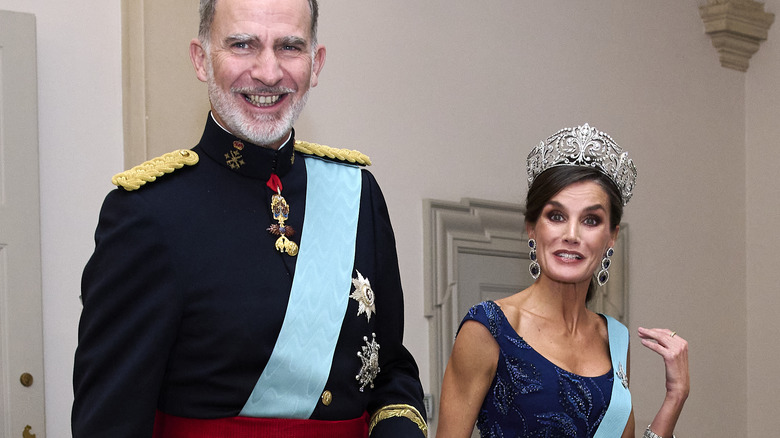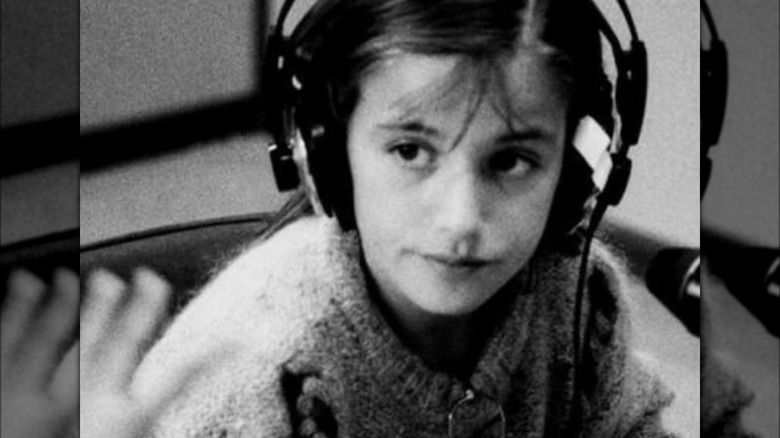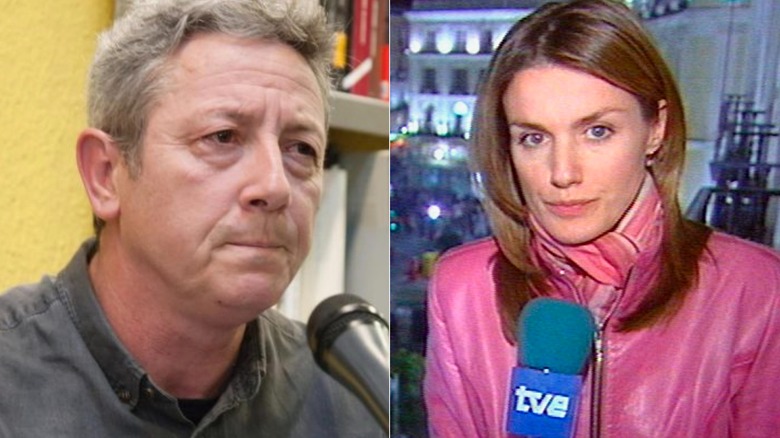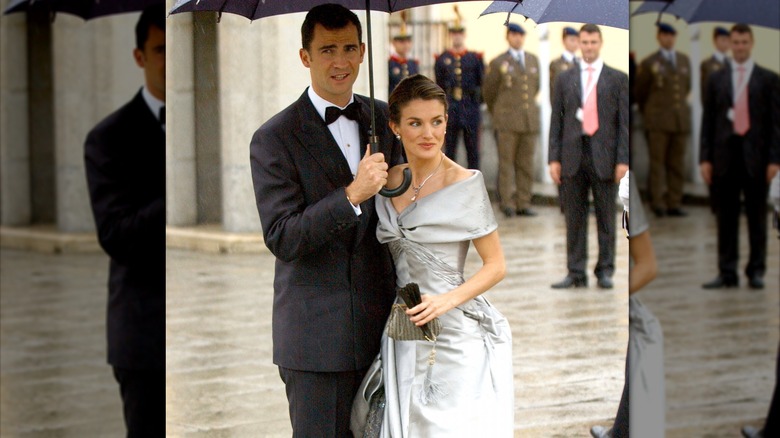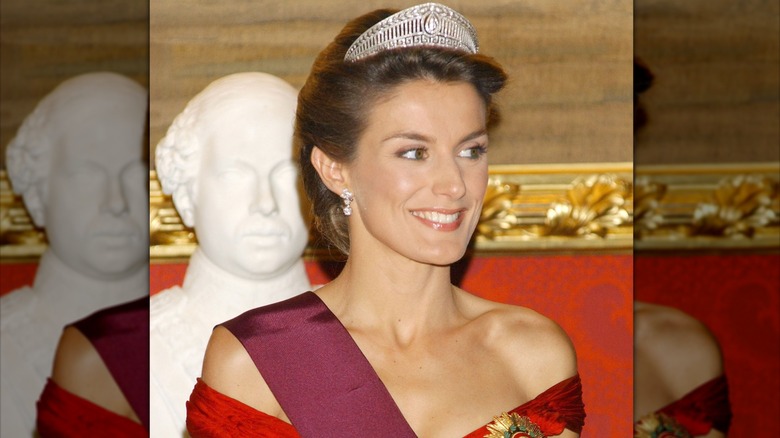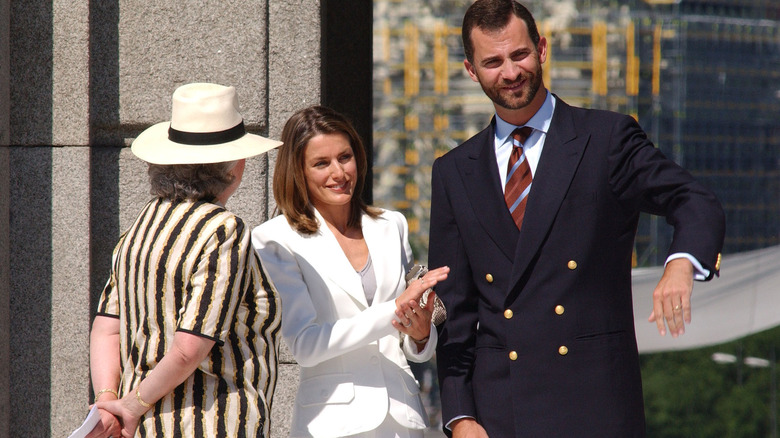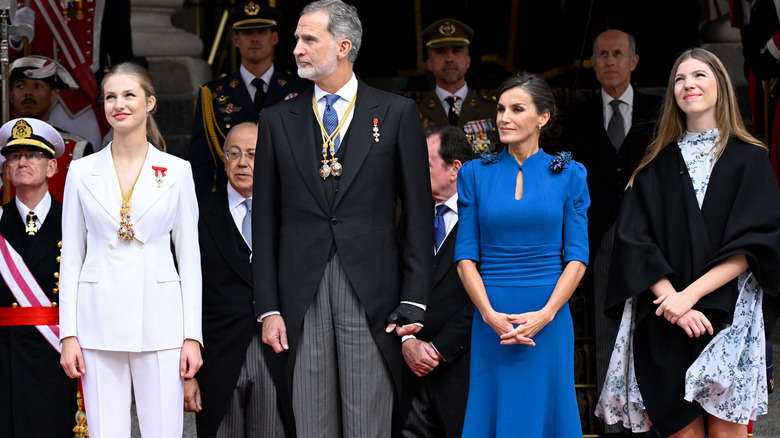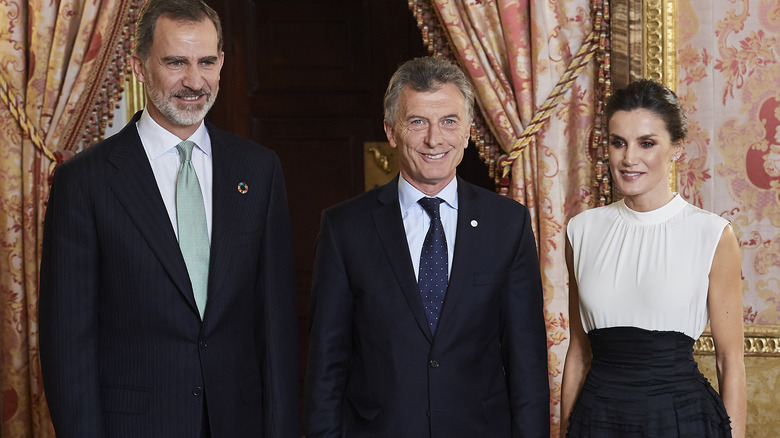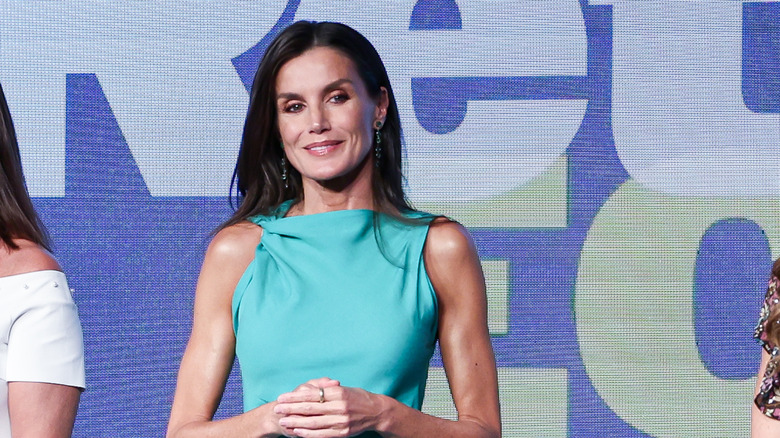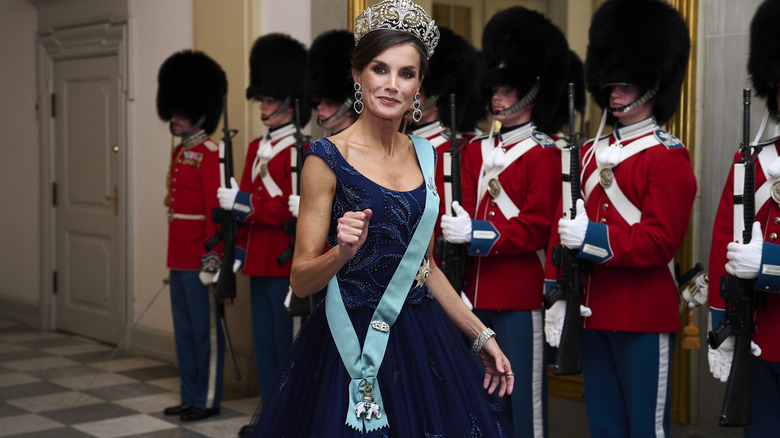Queen Letizia's Life Was Never The Same After Meeting King Felipe
The following article includes references to an underage relationship and human trafficking.
These days, Queen Letizia of Spain is known for being a powerhouse in the area of human rights and philanthropy. Since taking the crown, she has fought tirelessly to help feed and clothe people in situations of extreme poverty. As Letizia herself once stated in a speech for World Red Cross and Red Crescent Day, "Anyone in a situation of vulnerability, of illness, of need, of helplessness, violence, inequality, discrimination, loneliness, risk of
marginality, finds in the Red Cross a response, a kind voice, and a hand outstretched" (via Casa Real). Letizia has, of course, lived by these words, volunteering with the organization — sometimes even with the rest of the royal family in tow.
Despite the queen's undeniable dedication to these issues, she was not always in a position to give back to others. In fact, for much of her life, Letizia was a typical middle-class girl, living in Oviedo, a midsized town on the northern coast of Spain. As such, Letizia spent years doing many of the things that normal girls do: going to school, trying to get into a good university, and dating whomever she pleased.
It was not until 2002 when she met King Felipe — then still a prince — that Letizia's life was turned upside down. She fell in love, became a royal, and lost all of the freedoms that she had enjoyed before. Even so, Letizia's newfound titles gave her the chance to make a difference in both her country and the world.
Queen Letizia did not have a royal upbringing
Although Queen Letizia has long been lauded as one of Europe's most elegant royals, she was not exactly born into palace life. Unlike her predecessor, Queen Sofía, who can trace her roots to the Greek and Danish royal houses, Letizia was born to middle-class parents who resided in Oviedo, Asturias. Her mother, María de la Paloma Rocasolano Rodríguez, worked as a nurse, while her father, Jesús José Ortiz Álvarez, was a radio host and journalist. He had followed in the footsteps of his own mother, Menchu Álvarez del Valle, who was a well-known radio presenter in her own right.
As Letizia was growing up, it seemed likely that she would one day carry on the family tradition. During her early years, she was a frequent visitor down at the local radio station. By the time she was 9, she was hosting weekly radio dramas. Soon, the young journalist took on even more responsibilities, engaging in voiceover work for her very own record chart.
Because of these childhood experiences, Letizia eventually decided to go to school for journalism. She pursued her degree at the Complutense University of Madrid — one of Spain's most prestigious universities — and later went on to earn a master's in audiovisual journalism at the Institute for Audiovisual Journalism Studies. Although Letizia was preparing for a career in the public eye, few could have guessed where her education would take her.
She experienced a lot of freedom during her single years
Because Queen Letizia was not raised as a royal, she was not expected to behave like one. When she completed her studies, Letizia did not attend society parties or jet off to a beach somewhere. Instead, she did what most other middle-class girls do — and joined the workforce.
Luckily, Letizia's career got off to a great start. She began working for Bloomberg and CNN, before eventually signing with TVE. In this capacity, Letizia enjoyed a tremendous amount of freedom. In contrast to the first ladies of previous generations, who were bound by the strict rules of the aristocracy, Letizia had free rein over her own life. As a reporter, she traveled all around the world, seeing new places and interviewing strangers in the streets. At times, she even found herself in perilous situations, reporting on the Iraq War from the front lines.
Although this work must have been exciting, it was remarkably different from anything that a future queen consort had done before. As Letizia's former colleague, Sagrario Ruiz de Apodaca, revealed in the documentary, "Spain's Queen: From Journalist to Monarch": "She was an all-purpose journalist, one who was always available and willing to travel to any country to report on crises and any other events. She was completely independent. It can't be easy for someone like that to become part of the royal family and to have to adhere to protocols."
Before becoming royalty, Letizia married and divorced Alonso Guerrero Pérez
Over the years, many royal women have found that their personal lives were closely monitored to prevent them from getting involved with the "wrong" type of man. As a middle-class woman, however, Queen Letizia perhaps had the opposite experience. This was especially clear in her relationship with the writer and literature teacher, Alonso Guerrero Pérez.
Letizia's relationship with Pérez was far from orthodox. The two met at the IES Ramiro de Maeztu school in Madrid shortly after Letizia's parents had moved to the region. She was a lonely teenage student. Pérez was a 25-year-old literature teacher, nine years older. Apparently, the man developed an interest in his pupil, who, in turn, admired his prose. Within a year, they were dating.
As controversial as this arrangement may seem, there was no rule preventing Letizia and her teacher from seeing each other romantically. As reported by Mujer Hoy, Spanish law at the time dictated that instructors could not have relationships with students under the age of 16. As soon as Letizia reached that age, there was nothing that could be done to stop her from seeing Pérez — no matter how unethical the relationship. The two continued dating throughout Letizia's time at university and the early years of her career. In 1998, the couple tied the knot in a civil ceremony in the village of Almendralejo. A year later, they were divorced.
After meeting King Felipe, Letizia changed her wardrobe
On November 13, 2002, the entire course of Queen Letizia's life was changed forever. The Prestige oil tanker sank off the coast of Finisterre, Spain, creating the worst environmental disaster that the country had ever seen. In order to report on this groundbreaking news, Letizia was dispatched to the small Galician town.
It was there that she first crossed paths with King Felipe, who was in the region to show his support for those affected by the oil spill. Apparently, the two were both invited to the same dinner party and hit it off immediately. Before long, Letizia and Felipe were an item — albeit a top-secret one. Determined to keep their romance out of the papers, the pair tried to avoid meeting in public.
Even so, Letizia began to make small changes to the way she dressed, slowly scaling up the formality of her clothes. As her colleague, Sagrario Ruiz de Apodaca, explained in the documentary, "Spain's Queen: From Journalist to Monarch," "There was only one thing I noticed back then. She would come into the office looking a little fancier than normal. Before that, she used to wear jeans. She was always well-dressed but casual. And then that summer, I also saw her wearing dresses. I was a bit surprised by that, but that was all. We had no idea that she was with the crown prince."
When she got engaged to Felipe, Letizia gave up her career
Blue jeans were not the only thing that Queen Letizia gave up as she fell more and more in love with King Felipe. She also walked away from her career as a journalist. On October 31, 2003, the reporter read the news for the last time. Not so coincidentally, on that very same day, Letizia's engagement with Felipe was announced on the show "Con T de Tarde," which was then hosted by Terelu Campos.
As fitting as it may have seemed for Letizia to have announced her own engagement on live TV, this was, unfortunately, impossible. Given the press commotion that always surrounded her groom-to-be, Letizia needed to be protected from the paparazzi at all costs. Thus, the journalist had to gather her belongings as quickly as possible so that she could vacate her apartment before anyone could catch her there. She was then taken to her new home at the Zarzuela Palace, where she would benefit from security. Casa Real confirmed Letizia and Felipe's relationship hours later.
Reflecting on this intense time in the documentary, "Spain's Queen: From Journalist to Monarch," journalist Almudena Martínez-Fornés recalled just how intense the media reaction truly was. "Her flat would have been under siege. It would have been impossible. There was just so much expectation. To make sure that she was safe and to protect her from the huge media storm, she was taken to the Zarzuela Palace."
She had to learn about royal protocol
Like many royal brides, Queen Letizia has been known to struggle with the idea of protocol. However, her issue has not necessarily been remembering these unique traditions, but rather learning to embody them. As a career journalist who had once roamed the world, Letizia may have felt that these royal rules were restricting her independence. Speaking about this matter in the documentary, "Spain's Queen: From Journalist to Monarch," the queen's former colleague, Sagrario Ruiz de Apodaca, said, "It was difficult for her to adapt and to give up her freedom."
After marrying King Felipe on May 22, 2004, Letizia grappled with her new role. She especially struggled with the expectation that, as a royal, she could no longer go public with her opinions. Of course, on certain occasions, the newly crowned royal did a better job of maintaining neutrality than others. As commentator, Tereixa Constenla, noted in El País in 2014, "The princess thinks and sometimes — and this is the novelty — she says it."
The article went on to reference an instance when Letizia's political views might have slipped at a seminar on the importance of language. Apparently, the royal told crowds, "It is not the same to say 'aid' as 'rescue,' recession due to negative growth, or 'restructuring' instead of 'cuts.'" According to Constenla, this was "a freedom that Queen Sofía or her children would never have taken." But, as a former reporter, Letizia would not be silenced.
She had two daughters, Princess Leonor and Infanta Sofía
If marrying King Felipe represented a major life change for Queen Letizia, things only intensified for the royal bride once she had children. This became evident on October 31, 2005, when Letizia and Felipe welcomed their firstborn daughter and the heir to the throne, Princess Leonor. Two years later, they expanded their family even more with the birth of Infanta Sofía on April 29, 2007.
Because of her middle-class origins, Letizia did not stick to the tradition of maintaining a certain distance between royal parents and royal children. Instead, she sought to create as cozy of a home environment as possible, one where she could bond with her girls. Video footage of the royal family reveals that Felipe and Letizia try to drive their children to school themselves — and even pester them about their exams.
Naturally, though, this level of parental involvement poses a different type of problem for the royal household, mainly in terms of juggling responsibilities. Like many other working moms, Letizia has had to balance her maternal role with her royal duties. And, according to the journalist, Almudena Martínez-Fornés, the queen worries about whether she really can do it all. As Martínez-Fornés put it in the documentary, "Spain's Queen: From Journalist to Monarch": "She talks a lot about [achieving a work/life balance] in private. She also asks journalists how they manage to find that balance."
The queen has faced media criticism and scandals
Achieving any sort of normalcy, however, has been all but impossible for Queen Letizia. Because she is often in the public eye, the royal has faced a tremendous amount of scrutiny. And, over the years, her gaffes have landed her in complicated positions. One such moment occurred in 2017 when Letizia was attending an event with Argentina's then-president, Mauricio Macri. During the dinner portion of the evening, Macri stood to give a toast to the Spanish crown. But, near the end of his speech, just as he was reaching for his glass, Letizia interrupted him in front of a room full of guests ... to tell him that he had grabbed the wrong glass.
Unsurprisingly, the media commentary was explosive. While some outlets, like Look, described this moment as a horrific misstep, others, like El Mundo, considered the queen a valiant heroine who was saving the prime minister from embarrassment. Either way, this level of scrutiny was something that Letizia could have never imagined before meeting King Felipe.
Ultimately, Letizia has had to accept that, as a royal, she now lacks privacy. She faced this reality on a particularly deep level in 2018 when her ex-husband and former teacher, Alonso Guerrero Pérez, published "El Amor de Penny Robinson," a not-so-subtle work of fiction about a man whose ex-wife becomes queen. It was largely believed to have leaked the intimate details of Letizia's private life, even referencing supposed nude photos.
She gained a platform to talk about women's rights
Despite some of the obvious drawbacks of joining the royal family, Queen Letizia's life since meeting King Felipe has not been all bad. Although living in the spotlight has been challenging for the queen, it has also given her the opportunity to promote the issues that she cares about. According to the documentary, "Spain's Queen: From Journalist to Monarch," Letizia has made huge strides in the area of women's rights, dedicating herself in particular to the area of sex work and human trafficking.
Per a 2011 report by the United Nations, Spain has the third biggest market for sex work in the world. Documents released by the Spanish government show that up to 90% of sex workers in the country — mostly women — are being trafficked, as reported by The Guardian.
Since taking the throne, Letizia has teamed up with APRAMP, an organization that helps victims of trafficking become reintegrated into society. As APRAMP representative, Rocío Mora, told documentary-makers, "The queen immediately understood how she could help us. She worked out where things were missing. It was great!" She pointed out that the involvement of a royal gives the organization a reach that would otherwise be impossible. Mora added, "We want her on our side. We want her to carry on working for us, especially given her very clear stance on the issue of human trafficking."
Letizia learned how to master the art of the state visit
Philanthropy was not the only new skill that Queen Letizia gained after meeting King Felipe. She also learned how to be the first lady of Spain, welcoming foreign dignitaries and their wives to her home country. As the historian Charles Powell revealed in the documentary, "Spain's Queen: From Journalist to Monarch," "It's the king who has the power to represent the country, but it's much more effective if [he and the queen] do it together." Because of this, Letizia can frequently be found chatting with other first ladies on official visits, entertaining them, and making sure that they enjoy their time in Spain.
Fascinatingly, though, no clause in the Spanish constitution obligates Letizia to perform this role. This means that she has had to figure it out along the way. In the same interview, Powell noted just how difficult this has been for Letizia, especially given the way that times have been changing. The historian told documentary-makers: "King Felipe represents a new era. So, the question is: What does that mean for the role of the queen?"
So far, Letizia has modernized her responsibilities by asking foreign first ladies to collaborate with her on social projects. When Dr. Jill Biden visited Spain in 2022, Letizia invited the American to help raise awareness about cancer research. Together, the two women visited the headquarters of the Spanish Association Against Cancer — making the visit a huge success.
